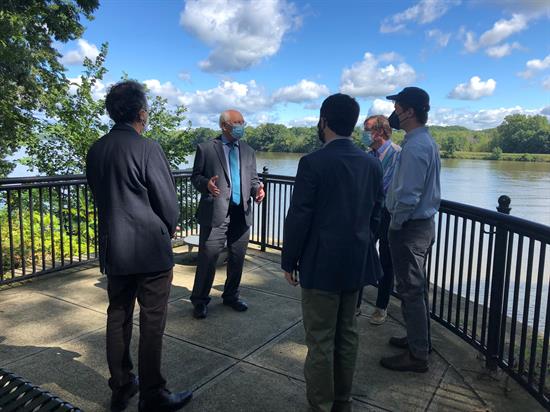- Home
- About
-
Constituent Services
- Academy Nominations
- Community Project Funding
- Congressional Art Competition
- Congressional App Challenge
- Congressional Commendation
- Event Invitation
- Grants
- Help with a Federal Agency
- Internships
- IRA Clean Energy Consumer Benefits
- Know Your Rights: Immigration
- Request a Meeting
- Request Surplus Books
- Presidential Greeting
- Visit Washington D.C.
- Issues & Legislation
- News
- 20th District
- Contact

Press Releases
Maloney, Tonko, Ryan Urge Further Action on Hudson River PCB Cleanup
Newburgh,
October 17, 2022
Newburgh, New York — Today, Rep. Sean Patrick Maloney (NY-18), Rep. Paul Tonko (NY-20), and Rep. Pat Ryan (NY-19) wrote a letter to EPA leadership calling for further action to ensure the complete cleanup of pollution in the Hudson River by General Electric (GE) following the announcement of a settlement between the Environmental Protection Agency (EPA) and GE. The Congressmen applauded EPA leadership on this critical next step in addressing the impact of PCB pollution in the Hudson and reiterated their calls for comprehensive remediation. “For years, I’ve been demanding the EPA take more action to hold GE accountable for the decades they spent dumping more than a million pounds of PCBs into the Hudson,” said Rep. Maloney. “I’m pleased to see both the EPA and GE taking this matter seriously, but it is crucial that this settlement is just the first step in a process that leads to accountability and complete cleanup of the Hudson River.” “I’m thankful that the EPA and GE are moving forward to more fully address and review the impact decades of pollution has had on our cherished Hudson River and its neighboring communities,” said Rep. Tonko. “It is my hope and expectation that this review will be carried out as quickly and thoroughly as possible and, most critically, that the voices and insights of those who have been most impacted are regarded with the utmost priority.” “For decades, our community has been forced to deal with the inexcusable toxic mess General Electric caused in the Hudson River. This agreement between the EPA and General Electric to investigate PCB pollution in the Hudson River represents an important step forward in protecting this iconic waterway at the heart of our districts,” said Rep. Pat Ryan. “But we must go further. I join my colleagues in calling on General Electric to fully commit to cleaning up the Hudson. Only then will we finally be able to restore this crucial landmark.” *** Background:
EPA Settlement with GE:
History of GE’s Pollution:
*** Dear Administrator Garcia:
We are writing regarding the recent announcement that the EPA secured an agreement with General Electric (GE) for an investigation of polychlorinated biphenyl (PCB) pollution in the lower portion of the Hudson River. We are greatly appreciative of the EPA’s continued attention to this ongoing issue and believe the EPA can take additional steps to restore the Hudson River and protect this treasured landmark of our districts. To maximize the effectiveness of this agreement, the EPA must commit to moving towards a Remedial Investigation/Feasibility Study, incorporate local voices into the process, and fully analyze the effects of this pollution on local fish species. The Hudson River is a celebrated natural resource that provides habitat for wildlife, clean drinking water for our communities, and world-class scenery and recreational opportunities to New Yorkers and its many visitors. The well-being and quality of life of millions of New Yorkers are inherently linked to the Hudson’s countless natural systems and habitats. Unfortunately, for nearly thirty years in the mid-twentieth century, two GE facilities discharged more than 1.3 million pounds of PCBs into the Hudson River north of Albany. This pollution has led to the Hudson River being designated as America’s largest Superfund site, stretching 200 miles through New York. These toxins have had a significant impact on public and environmental health – from moratoriums on fishing to increased cancer rates among nearby residents. It is long past time that the river is cleaned up for good. We applaud your leadership in working to advance the Hudson cleanup and believe that the recent agreement with GE to investigate PCB pollution in the lower portion of the Hudson Superfund Site is a step in the right direction. However, we believe that this process must lead to the critical next phase in the Superfund process — a Remedial Investigation/Feasibility Study that could provide the first step toward developing a recovery process that will benefit all impacted communities. Secondly, all voices must be heard and included throughout every step of this process. Currently, there is a lack of representation from the lower Hudson on the Community Advisory Group, including groups addressing environmental justice and disadvantaged communities. These groups possess invaluable expertise about the unique harm PCB contamination has caused their core constituents. To achieve an equitable recovery, they must have a seat at the table. Thirdly, we urge the EPA to conduct an angler survey to gain a better understanding of how extensively vulnerable communities continue to catch and eat contaminated fish despite posted health warnings. In addition to increasing awareness about people’s reliance on the river for subsistence, the study can help inform outreach to protect them against further harm. Finally, to fully restore the Hudson River we encourage you to continue to work with the community and GE to reach a settlement that will result in a complete cleanup and restoration of this waterway. The diverse communities who call our region home have suffered for more than 70 years from this unprecedented contamination. They should not have to wait decades longer for it to be addressed, and we can and must move faster to finally restore the Hudson. Thank you for your dedication to the people of New York and this nation. We look forward to your prompt action on this critically important matter. Sincerely,
Sean Patrick Maloney Member of Congress
Paul Tonko Member of Congress
Patrick K. Ryan Member of Congress |
